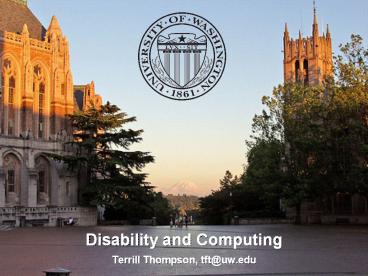Disability%20and%20Computing PowerPoint PPT Presentation
Title: Disability%20and%20Computing
1
Disability and Computing
- Terrill Thompson, tft_at_uw.edu
2
The Alliance for Access to Computing Careers
UW Department of Computer Science Engineering DO-IT (Disabilities, Opportunities, Internetworking Technology)
3
Goal
- To increase the participation of students with
disabilities in computing careers.
4
Google agrees.
5
Barriers to Success
- Diminished/different support systems at different
academic levels - Little access to successful role models
- Inadequate self-advocacy skills
- Lack of access to technology that can increase
independence, productivity, participation - Inadequate accommodations
- Low expectations other negative attitudes on
the part of people with whom they interact - - National Organization on Disabilities
6
Lack of access Inadequate accommodations
7
(No Transcript)
8
(No Transcript)
9
(No Transcript)
10
(No Transcript)
11
(No Transcript)
12
(No Transcript)
13
(No Transcript)
14
(No Transcript)
15
(No Transcript)
16
(No Transcript)
17
(No Transcript)
18
(No Transcript)
19
Assistive technology may be part of the solution,
but AT alone does not remove all barriers.
20
(No Transcript)
21
(No Transcript)
22
(No Transcript)
23
(No Transcript)
24
(No Transcript)
25
(No Transcript)
26
(No Transcript)
27
(No Transcript)
28
As we create, purchase, teach, and use new
technologies, how can we ensure that they dont
erect new barriers?
29
Legal Requirements
- Section 504 of the Rehabilitation (1973)
- Americans with Disabilities Act (1990)
- Section 508 of the Rehabilitation Act, Amended in
1998
30
Guidelines Standards
- W3C Web Content Accessibility Guidelines 2.0
- Perceivable
- Operable
- Understandable
- Robust
- Section 508 Standards
31
Barriers to Success (Revisited)
- Diminished/different support systems at different
academic levels - Little access to successful role models
- Inadequate self-advocacy skills
- Lack of access to technology that can increase
independence, productivity, participation - Inadequate accommodations
- Low expectations other negative attitudes on
the part of people with whom they interact - - National Organization on Disabilities
32
Exploring This Problem Today
- Student Perspective
- Other Stakeholders
- What can we do to help?
- How can we collaborate?
- Everyone
- What are the problems?
- What are the solutions?
- What are the next steps?

